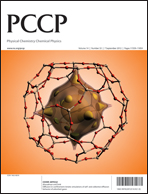In this paper we report different theoretical approaches to study the gas-phase unimolecular dissociation of the doubly-charged cation [Ca(urea)]2+, in order to rationalize recent experimental findings. Quantum mechanical plus molecular mechanical (QM/MM) direct chemical dynamics simulations were used to investigate collision induced dissociation (CID) and rotational–vibrational energy transfer for Ar + [Ca(urea)]2+ collisions. For the picosecond time-domain of the simulations, both neutral loss and Coulomb explosion reactions were found and the differences in their mechanisms elucidated. The loss of neutral urea subsequent to collision with Ar occurs via a shattering mechanism, while the formation of two singly-charged cations follows statistical (or almost statistical) dynamics. Vibrational–rotational energy transfer efficiencies obtained for trajectories that do not dissociate during the trajectory integration were used in conjunction with RRKM rate constants to approximate dissociation pathways assuming complete intramolecular vibrational energy redistribution (IVR) and statistical dynamics. This statistical limit predicts, as expected, that at long time the most stable species on the potential energy surface (PES) dominate. These results, coupled with experimental CID from which both neutral loss and Coulomb explosion products were obtained, show that the gas phase dissociation of this ion occurs by multiple mechanisms leading to different products and that reactivity on the complicated PES is dynamically complex.
![Graphical abstract: Collision induced dissociation of doubly-charged ions: Coulomb explosion vs. neutral loss in [Ca(urea)]2+ gas phase unimolecular reactivity via chemical dynamics simulations](/en/Image/Get?imageInfo.ImageType=GA&imageInfo.ImageIdentifier.ManuscriptID=C2CP41379E&imageInfo.ImageIdentifier.Year=2012)
You have access to this article
 Please wait while we load your content...
Something went wrong. Try again?
Please wait while we load your content...
Something went wrong. Try again?
![Graphical abstract: Collision induced dissociation of doubly-charged ions: Coulomb explosion vs. neutral loss in [Ca(urea)]2+ gas phase unimolecular reactivity via chemical dynamics simulations](/en/Image/Get?imageInfo.ImageType=GA&imageInfo.ImageIdentifier.ManuscriptID=C2CP41379E&imageInfo.ImageIdentifier.Year=2012)

 Please wait while we load your content...
Please wait while we load your content...